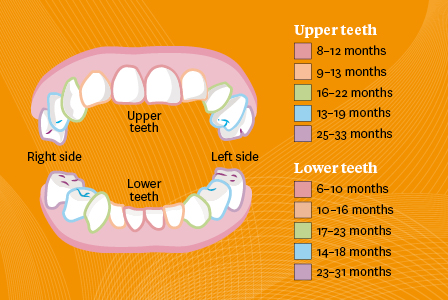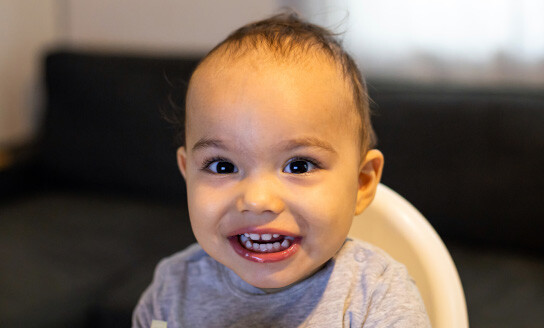Baby teeth order
Baby teeth can come through in any order, but most often the central bottom teeth are first to break through.
Here’s the usual order teeth come through the gums. Don’t worry if your baby’s teeth follow a different pattern – they’ll all break through the gums at some point.

Ministry of Health
Teething
Every baby reacts differently to teething. Some babies’ teeth pop through the gums without any problems, but for others teething can be painful and upsetting.
Your teething baby may:
- drool more
- develop a dribble rash on their cheeks or chin
- cry or seem grumpy
- have a slight fever
- have red cheeks
- not eat or sleep well
- want to suck on or bite things
- pull the ear on the same side the tooth’s coming through
- seem to be filling their nappy more than usual, or have different poo (which may cause nappy rash).
Teething doesn’t make babies sick. If your baby isn’t well, it’s always best to take them to the doctor, especially if they have a fever or diarrhea, or you’re worried about any other symptoms.
How to help your teething baby
It can be really upsetting to see your baby in distress. Here are some things you can do to help:
- use a clean finger or the back of a cold spoon to gently rub their gums
- wrap ice cubes in a clean face cloth and place it on your baby's cheek
- give your baby something to chew on, like
- a clean teething ring (especially one you can cool in the fridge)
- other cold things that they can suck on, like chilled fruit wrapped in a muslin cloth so they can’t chew bits off and choke on them
- try a teething gel from the chemist (carefully follow the instructions on how to use it).
If your baby still seems unhappy or uncomfortable, it’s time to see your GP or child and family health nurse. Teething might not be the problem.
Teething and breastfeeding
New teeth are super sharp, and it can really hurt if baby bites you while you’re breastfeeding. Pulling them off the breast while they’re biting can be even more painful.
If your baby’s a biter, try taking them gently off the breast when they bite (by inserting your finger in the corner of their mouth to break the suction), have a short break, and then try again. Doing this every time they bite will teach them that breastfeeding stops when they do it.
Your baby’s first teeth are important to help them eat and speak properly, and they guide the development of the second set of teeth. That’s why you need to look after them.
You can start caring for and cleaning your baby’s gums well before the first tooth appears. Just wrap a clean, damp facecloth or gauze around your finger, and gently wipe their gums a couple of times a day. This is a good idea because it gets them used to letting you touch their teeth and gums.
How to brush your baby’s teeth
As soon as teeth pop through, you can clean them twice a day (in the morning and before bed). You can use a small soft toothbrush with a thin smear of fluoride toothpaste (see below) to gently brush your child’s teeth. Fluoride makes teeth stronger and reduces tooth decay (holes).
Babies can be super wriggly, and getting them to sit still to have their teeth cleaned can be challenging - but it’s worth the effort. Here’s how to do it:
- place your baby in a position where you can see their mouth, and where they feel secure
- cup your baby’s chin in your hands, with their head resting against your body
- clean their teeth using gentle circular motions
- lift their lips to brush the front and back of the teeth and at the gum line
- when you’ve finished, rinse the toothbrush with tap water, and store it upright in an open container so it can air-dry. Make sure it doesn’t rest against other family members’ toothbrushes, so decay-causing germs won’t travel between brushes and into your baby’s mouth.
Replace toothbrushes every three to four months, or when the bristles get worn or frayed.
Which toothpaste to use for babies
Use a 1000 parts per million (ppm) regular-strength fluoride toothpaste for your baby's teeth. See the below toothpaste advice chart on which toothpaste to use, which ones to avoid, and how much to use.
(1000ppm fluoride is equal to 0.22% sodium fluoride or 0.76% sodium monofluorophosphate).
Choosing a toothpaste and how much to use (PDF, 1.3MB)
Choosing healthy drinks and food
At around six months old your baby might be ready to start eating solid food, and to start drinking from a sipper or open cup.
Once you introduce your little one to solids, you can start to offer water for additional hydration. After the age of 6 months, only water from a tank or bore needs to be boiled and cooled before offering (until age 18 months).
Between six and 12 months, breastmilk, infant formula or water are the only liquids your little one needs.
If you are offering breastmilk or infant formula in a bottle, it is important not to allow your baby to fall asleep with the bottle. When a baby feeds from a bottle, the milk comes out into the front of their mouth and settles around their teeth. If they fall asleep with a bottle in their mouth, it may slowly leak any remaining milk left in the bottle into their mouth. This can result in tooth decay.
See our Introducing solids page for some healthy food options when starting solids. Do not add salt, sugar, or sweeteners into food, and avoid sweet treats which may lead to tooth decay.
Read more about teeth and teething
Learn more about looking after infant and toddler teeth
Last updated: 19 September 2025
